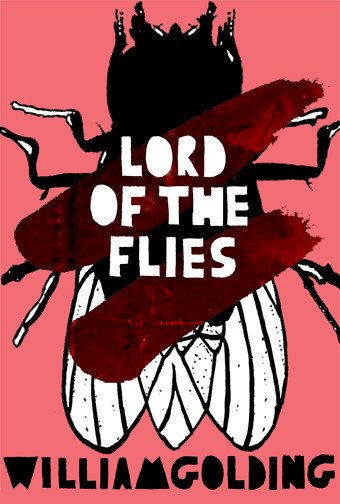 Lord of the Flies
Lord of the Fliesby William Golding
reviewed by Katie Pallares
In his novel Lord of the Flies, William Golding explores humanity’s inclination to brutality and chaos as opposed to civility and order. Lord of the Flies begins during an unnamed war, with a group of English schoolboys stranded on an island after a plane crash. At first, the boys try to establish a well-run society mirroring their own, with rules and expectations geared towards their rescue. The boys choose Ralph as their leader, whom Piggy guides with rationality and intelligence, and Jack and the rest of his choir as their hunters. Ralph decides that the group’s biggest responsibility is keeping a fire going at the top of the hill to emit smoke for passing ships to see. However, with the growing animosity between Ralph and Jack and the emergence of a fearful “beast”, the boys lose sight of their goal for rescue and begin to side with the often barbaric Jack. At first their aggressions start off small, such as teasing Piggy and disagreeing with one another, but as the storyline progresses, many of the boys follow Jack into ritualistic hunting, chanting, dancing, and even leaving a pig’s head as a sacrifice to the beast.
Golding uses a plethora of imagery to describe the island and the situation the boys are thrust into. He also uses metaphor to compare major characters and objects to ideas in society: Ralph symbolizes leadership and civilization as he tries to get the boys to understand that rules and order are important. Piggy, who often points out the obvious and criticizes the boys for their immaturity and foolishness, stands for intellect and rational thinking, and the conch that he and the boys treat with awe and respect symbolizes democracy. Jack represents savagery, selfishness, lust for power, and immorality, with his tribe of hunters painting him as somewhat of a dictator. Simon, generous, helpful, and kind, is a figure of morality and goodness, with many similarities with Jesus. The beast is a metaphor for the barbaric instincts within all the boys, and, finally, the pig’s head on a stick is a stark opposite to the conch, as it is a symbol of cruelty and evil. Using these metaphors, Golding equips the reader with a better insight to the boys as they try to form a society and are met with disfunction.
I definitely recommend this book, especially to those interested in philosophy and civilization. Golding’s recurring theme of the primal instincts of savagery is nothing less than gripping. I was surprised a the novel’s effect on me: I found myself concerned with the characters’ well beings . In his short novel, Golding managed to make me feel shocked, uneasy, and even mournful as the plot progressed. Lord of the Flies is a classic example of high quality literature, and ultimately unfolded as an interesting, thought-provoking story.
nice information very interesting , good job
ReplyDeletedevops course